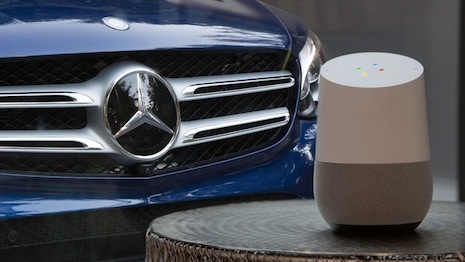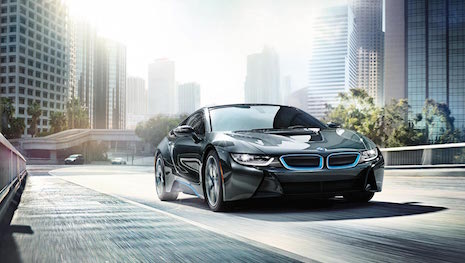The highest sales for super-luxury vehicles are coming from markets such as the United States, the Middle East and China, according a new report from Frost & Sullivan.
While manufacturers in the U.S. are focusing on electric technology, European automakers are concerned with autonomous driving and cabin comfort for passengers. In 2016 compared to 2015, super-luxury automotive brands saw a significant increase of 8 percent in sales.
"Electrification is the future of the premium high performance sector,” said Anjan Hemanth Kumar, Research Manager, at Frost & Sullivan, London. “In the next five years Frost & Sullivan expects more than 45 electrified premium high-performance cars launched by every traditional and new age niche-market players."
Automotive innovation
Automotive sales for luxury vehicles in the past year have grown to $6.85 million with brands such as BMW, Mercedes-Benz, Tesla, McLaren and Maserati leading in sales.
Practicality mixed with luxury has been a major driver in this category, with affluent consumers continually looking to SUVs and crossovers. These consumers are looking for vehicles with cutting-edge technology, innovation and the ability to customize.
 Mercedes-Benz partners with Google Home as more automakers value technology
Mercedes-Benz partners with Google Home as more automakers value technology
Original equipment manufacturers are hoping to attract consumers with luxury technology such as infotainment, safety and driving features.
Flagship sedans and SUVs are continually being introduced to the ultra-luxury sedan and sports car market.
 BMW i8 electric
BMW i8 electric
However, up-and-comers are introducing more electric vehicles to the luxury market such as Lucid, Fisker and Faraday Motion. Electric luxury cars from these brands will likely become available in 2019.
It is likely that more than half of ultra-luxury automakers will sell hybrid and electric cars by 2020.
Bespoke customer options have driven the average profit for each vehicle above $15,000.
Another major push forward this year was the increase of technology in the autonomous driving sector. Operating on a five-point scale, driverless options are at around a three currently, but Frost & Sullivan that by 2020 autonomous driving may reach a five.
This means vehicles will likely be able to operate without steering wheels and pedals.
Additional insight
Another report from J.D. Power shows that there is still room for improvement despite automotive technology’s substantial growth in recent years.
New vehicle quality is at an all-time high, according to research in the J.D. Power 2017 U.S. Initial Quality Study, but problems are still occurring for owners when it comes to technology. The most common issues seen in new vehicles are related to audio, communication, entertainment and navigation (see more).
The automotive industry in the United Kingdom has also hit its seventh year of consecutive growth capped off with record-breaking sales.
Last year, the auto industry in the U.K. saw a total of £77.5 billion, or $97.8 billion at current exchange rates, in turnover, according to The Society of Motor Manufacturers and Traders. Vehicle production per employee is on the rise, but also the industry is simultaneously reducing its waste (see more).
"To gain a competitive advantage, OEMs should focus on building vehicles with significant convenience features in addition to maximum customization options," Frost & Sullivan's Mr. Kumar said.
"Super luxury vehicles are expected to be among the first to feature level four autonomous technologies by late 2018 and level five by 2020 as customers are eager to pay for advanced features that are unique and luxurious," she said.
{"ct":"MBBR9AdGNR\/zmVQ6XtZ4Obtbcm4wp5i7p64JMde8qRAnxc5vTmJ9X\/czJjmpDMYzkIfxvWlj7nQFyYISZS8tN+jTTKCB4\/FeiFDk1NCecgHNoSppbNfxU1wKPkJ5VxOsK0Z1\/I5qze7VL50F9T\/3Hnfyl+pPfrOhV7PNn2AbHgMUO6JmwZToaKGnXR+XDC\/yKrzj4kyaEcSPu7WFsoYVqzquFHYrS50JRpvrN9kb404ETTba9PFeKDIGikVfOrUWfVbMLikAbT7zUfaX09VHKXj7ptvQTrkzrSP5t9tfSeqxzCpwyHf\/wYi4fXR0EG8SmOX7aA0cxQt6f0glK6zaho0KDxKREtU12CRuhVsbvNKiUPaWQ2mPvQ6uR8DX\/FU4ooh2WpM3jdyYsChN\/bmOvYnALkP58ZdS371OPVZNKjM74XgvOjcblAct17YYIf9w4ik4OOAcNDZG2wcBtHiom2a3E4MwnOosFuTNHHdvTaIRqh4y\/U6nvIUXRskmPutAiQ873bOaphpYWlTWmSfBC8sqfqoGRhWCBDWjgZrEb8389prVoYOVYvVw+Ta530Pd91E8Yd112PsBWCluARJckxhbUEaRlZrnALBdtuld2ha3Izae\/6fCCr2AIg5Xlt\/cxYoElm8vv4Vlq0s3qTM2dtR1\/Twfe5RLOJ23\/FbweXz7k4V4zr3ySRNfEi0xSTjJZitH53QOsOatwsJzB5p2\/lLfMHz5Y0bK58YhAU5V3jlV7kbIJCKGwDAfCQXaAmYri3pUJ1dUqzGUm49cyxOP+rvJzexgSMWMX\/yPgnI9rNacQs3cn+AJqPdPN6vR6+NNdNnLQgNBcgGoLjJtaqTQW1R8qtSzBc4qlxFYWFbgL2oT7rRomNPCLjbQkYrKQVoF5y9SqbVc3dJZTB5eXUjml+IMIwnq2zSPSnNah26r6UzoOMI6Nxw0rNMY7gjicy0NbhFyhcqR\/G4pftQTgBGpO8e24m4iSJujnz2diSr4zl614hMTAAt5ZGngejKS1zY\/Uon7nTK7R7+ahWSfZRB1wZohs6Ywb4JN\/A9mfq4w6bUxo9kaaLAGWSavJANfxYSfa9BskpgdvREU2O8WdVSuFw+sE4YPRfXQnlC4R2U87jAh\/HUja71q05M+4ZCF5HvU+G6rWbpZcQEMZtzRReTkfRFsJ0vIZDtCbJn8YbZPARqwBPodWrHn7CXCoQ38eJRNHjDeBlbdUB+f2dOC6VMmJkY2sQZL9ZMkpS+\/fkHLXpLosJW9KpLd2GMMTPN6A1B10Dx\/Rvkap39OGJqRwcwZwAlP2kFxZmkPvc5ZwJPwwoZxT4\/AEkpPj7y4qrVZcOsv+fxmOI1QqASSgnfPcMH29oJTh9SSZRLlYB7yTzIkFpgQTY6Lq2BexkUJH\/\/ROjGhz9rL\/HZ7+7XSXI5Sl+riLfN966cwdp\/kmCzwa21gyRrpS+NTkTj9f\/bT\/JB6TD5k7KMGhB0e1MgFevhw8nU\/4pq7tRiKxVpBylk+p0GKMNAJYpi+uxs2OMF1rLUQxKv9nsCeGnYnm7ZdkAv3oNpNmXrw0Tn7Gmbr8uIJ3Um5kx2ajvLn79lp1a\/JYi8DtQoIHEnrH9QV6fm56rn\/J4Gw+5+QQHNr8nzLUzzSTqxkrjMvTj10jjnSqrdBfAbH+Z7LtSjtjLsrnjfHbbkZCkijxX5wx3w2Of8ghGcVG+Ozx1SErs0y\/CHSEj\/WKqaDxPrf3yMjvduvqmBP2RxDiCjWnsI091LEy4eXDLgPvaO5xKPmzwzRivY+yFVLjJWr7maaS4S8mQe9CaRfz0ZSw8Q9\/f4r3VkkyKeqZ0t7\/gHCH1J7ssFpadnBceZd+n\/+zVLr7O1p6aoBOylg4hZDn7sqzLCi+des0dLZbmESs5P19l3XxMoXUO83dS9MVQGdl+bODqCjPMT2m9gwVw840Ac85dT8+r+mNaBg7y7itoi1QxEAlAi0MtVi7LSgbK4E\/gIPYZBwyyqJ7S4g8Y1ow\/\/6JsR737012uBZ2ShVA5717Zgkm3sqbF6nVhKEz7MtEe+HLccPWwb+5NVWbKv7JcZrNHDcqHYAh7ZVQyFE41Axt7NT3l0neV1rYp+rmTRiu7zO7F5dfjAIj3aEjPguObhQwgIkRkPiBzo7AHRjkPDReKQH+kw1QId\/t7FDM1WEEk+mMrvnbaC6cEZeZl1Qm+nMHjN\/E5Op1RJvpQgq44wxaTrFmeX4906rGAW0mdpphVaVk785PlqmIDOoqMhw2sRH2ptON13pPAJVSpa5eX54Wex8q1jO\/KZb5cFZatcn6uv9LI0MDQJFSl+hdavrrtP\/aSXURppqhNJjci0zZ1VKS3neXMp\/P5p5d\/2FnlBWOJtv80+vmxulYcE1g\/8BJtwZ7IQ6f2xOIzIn3c85ZANljOlCbwqBfw3BXj5v8SWVb9LPqp7mES4XZ+n+uVswL+a66l4gWL6K\/rFN12uYi9gOe1wzT6vj2Hs1GsL4lGqY2GYIGAQ9gRqtB6W0frlq0dM\/VpWdfxS2v6\/G3MrVNDS6gDjfHIcnfOPRZnN5N9+XCqjRI\/tkYXtNBUdmV2kCNV\/9cK40vJBIGNm+fMP+XsIgqFDGuwTfRoUx9Zp0RenXFwZItcE5fUvma8JSRGX2am6MUPIFW6Qz27bkwi4isr24F8DS64j77kdRjaA1KtsexYFrC7EfsDRxjT0kkN3hREsKwhvOa\/C4X2p81bJgZvwZ9TqtOjVDwP5Jf1cC+AXIIhm1eyVfRCwNjFdpC5CsDWluWyuU4mHxvMaWMozR98AMK\/VlHfj\/UipWYFnQe5Q8QKA1Crrt+WRLF9lusL8\/iTnnKWaNu6mwVqf1FUT818hvzWrgdAz0dwTnbYXQHoIzkSUMS+alqnnbrpzYBeYMkvog+Q7wL90xMPz466jgq4ds41v0EKO\/xbvkGFuOTBnfpNsuortYHS3P2jhECwHGTOZIYCxO14jitcHlQnfp+UQ5ERjTSOzbUbiCxgRzqyhKhZLyhKlEtOLHZjwbf6uXtj0OvvW6DYGn\/Xa+UCOfW5weVCvf+UmfM369SQszhkDhhZMC7luVxkjkMGBOoRYeYEKRadAnEIOpdXPG3zAB0W0+mDRyqqlWp\/7uTgXxMAqANVrO9uXMwTLUg56JEU4tjd1ZUkooJ7eGTit8a4Sby91O4W4WXgO05P6KkFQ+ccfpYb2SEy6eDLx+6n5W+xeDuXyCzYTpksl2OFSpjp9m6S\/0KQyvBs3whCSilDu31O7nVluJZrxkLrlTvDteGWo\/w758TSZxQAV8S7X\/RXdlW18wczn84VIvAK2iN6JsfW7Y3AayFl+harrA4WKQMQu4UJQpa47Aj\/eZz3nJkoocLhPcskrbUXVxqz3BmXZwc0axcDICbHDzS\/SG5ElHTBIUxlnLcBpqU3hx9ARa3Zc\/SwXXFy+A55slM\/eCLNUk4GtiCu6Ft9mK1nS53Mao+d0UVW9wEk7zAbUlpc\/a1\/1sFsw7A2M0yXcOujioJULm2QHnPewotz6caqXT7EiZPMwJtWlBjmnxfYV0gPXjF4W8If2CoCeDEjH+jqgcKA+s4rUDGYGidVggh\/OixbRROk4LtqkSad9pyPAC6n\/YuFlDbfZ9PgojK\/yCMVqKWjturlZldOfL46OvjEniBal\/dvMizzPAiuCMf6QZzMkgdKjIZem\/IBlMbB1LSciSjVB9XwC+RJH\/P3jDyM7BiFXFsdlL9IBtjfRwqKTa9bWjzvwMF5SXD8dg4EN58i6j45wV5rCwvFAlKmgZ0I\/VOqATOuSz62HBKbrj8WjIMs5RZP0HmwfUSI5JHQTrDjYCwrBovITy6nVKnDta1pqCtVEv63GJdzDxPB9wNCSfard61k91ss5Tbh9kG0A7gXckLH2yI2z\/lMUW3YIokJFbPfpq3SOmJBZu1oYSOCg1i8EMAZWS9IwktKZ7oyTCFXLpWloaX5mDPEezoQrkX3bVVY5ryRGKGbHAavrLiamfjzG22BAWfkxl1ynhsTRwsjZlWIvorTaiUbRjh6uIHx+HsA7chy2WjKxvCkFINSqwSvw3C4eMEYdP1idj3xBC3vUL2ht6eKJzstPk7y7uvSvJZnjPVI6hgDC7VsdSbkVmltVGvXPiQ239YQ8+y3pWpKP\/ciT7vc\/DbOFWVsRMUNYi4wsWXQL8Buiue9Lx9qB\/CMvnZazh2tGhW9lHCUB+sawxMXc41UE86\/KyDJBza35ANSWpZcjLsKX34hwPkb\/mZ4HJ7A8pFL4aICtuU847At\/S8Ug0hPHdMTxl\/4F0f4GLLYuIIlKqOmcBJSSNqhppRfBY5DTP9oHljf1y0MOPn544OMwOmSActFXobBFLoJPlFeoO8R\/U6AQrdMX2j1KfcCZ602zw2NvxJ3BT8mMGH29lTPBvXPnYd196yk6Zp1Kvgm2zNviIBcfSHx8pJ6SlzazuE8xOhz1IT0ViZIUxOpXJHEkmRV9jeM9kMKuQtsnWe71rmonVNEl6V5hKKOKUBnatAl1a1bJrHl9haViMU7YEUqvVFNjKP0kcehKH8bGPZa8fuGexStSFKuYtOCGwR197rCw6lqwgN6HXSoXo4cjllhchMq+JMAg24Z9Nf33xYiXI8E2O4Vgc2Dtg5p+DTCQao9Kxij4J93Y+gDdqfE8CzcBygsl0Bvav2AFLBtx0IiEuyaUweCgI3hKJvoW+kYK3GIfDmMvira0b1f9WYpFyab781\/n714AUmI0kIh5Vg+Lb7TA9gLe94h5d7PEy+h8\/2Y4nzzruNWN6sc+k0kK34LtydrarcIH\/ThQQLq9umcA66eTdhAjrys1x5dYDhJgvs6eFn+2Ai8BMFowEv1Xi5OocHrJxS5dg7IdbBgEZ0vaFumjQrlDhrrsHbk5pOpyo3CgbpNv1gP3IopzY3rWx+F7UUZObmGZm9hcvVLnG7em2r+hrcw+aWDRR5kZQ611wYs5NTh\/9Uwnn2yEaToF5USGHUhm65tZKdgHZxpsWDpwJLLCLzjXllvSurUWep1WImTaA1EUIqUeDrZ1LjD\/QN\/bw1589u1H93pcov8SecJzw1id8db+7jNzJuTpscR9eTxdrhy3RZ2afIUvfCd2P6xMm2UTWRgA9Yw6wqQheUNKJOm9P7RpvbLj8SYDejoqKcxWEchfUagVWnV\/RIbJABtqJNM52V\/LnPxQuele0CUx29wuOn\/CbZ47iYsTl1zTauvp40qTFm4\/DKrSZHgC7j0XAWjxTSOVnkKIG389pHmNdsGhjBr+FhXPAt4hMxBw9wlVRdBFTBjle2ck4Xi0vBNhvkNDpK370N1ZtmFCTQxtARcnmk99Npr5WPn7zIw5ern2EPr600uTbIp+txaN\/+MYAEU88UJ9w0dkkxiQHT4ESjFNeEsYOjJR2xdyMM2zepqQvhMHwka+lsyD2tDEWcFWnXqdYoz8ZLKZmmewlT4NakiSVRih0jMg48AQBVGl0zexL0v3cbVHfnmEUEOYlTxtMrFUKWe45guLejUMSPlpAPapmAv6Pvu2J4gkA4nhEIJv3eeo\/2RT7PTJ7xEiFsuTH6JlJaXlB2aDcBp3RnvzZzDmoNI\/YdBjvY3tFgIr6ZaPt8SWYk8FtHgEivbD4VV4b8Tsmxmi\/ryGJz28XcRxswpWb67fICN8TMreSb9ZePzHSM8o+R\/nZ2i4lm7SDy9TTmu1Ub6oo3GkEbrYHOgYyDLWf9MvLyvWFSL\/IEdkD1GbZp7UJu+PutC7Y5TW8r8WdjPcNv3jaftKvnh7TeTO03lr6g2qdc5naP75NA2ObwPnKn4HgCyllIx62LqWJmZz27k\/+uKJ7Rq7lO087XviEqRa9LYXsvX9rHhRauGa6u245bZ80yPSJ+OcQ09swt1MlWWIYSfN7JvQqt1atmUIOpsewzeVzdOtMpUteN5JUw0e9o2SyuLYCxy99tPXDffQiyYVte4HmZFMWCqL+NzY3E0ijo8nrxgDj08vbxBNT2oqWQYItF\/GA6K7qIm7f717aALOFdB3L5SpEViqzRggDsPofg\/PFlQB1+afVjE+8Kn2TTOwZr9Ov1bW4q75e\/xOdxLsvBTaJfvpZX3DZh2mwIZWhiwurH0Z1N+\/kts0oTYekVqDlkzm6q+kck0VacyETmr\/WAFa0ZYbu7hZbjXIgOFYrn3ROCk6G1vAHYclmCtp3jpgECHzUOxvRjFY5VkqVDJ4moJieJGbafDVH1GdGzN0UNXzlDPYO3aipqA\/XatDAOtxcpgk8vT3J\/V10LJNIxki+5RzzkNQqTa7nDpB4Beb2AU8Vz6N2gPu2vd398nKaeSh1hdX2VrHVZ+IrLAWxar8ROpFuYL95V88js6LOe1eH8VLBODxih\/JwdkkdrrRoRDH2DWsRxrLouUJK4bsYKs1khtqNSd2stQIMpmTP4st4siNhQRKSWWRskLi2YdefuhgtPI93aalkWQAdYzdlTOAGwId6G5W4WV98IqVd3GWJRuudvuxEY4M4T0XCb8QGZEU321DxzCGOdezEd8zcfAqV4nuCJW7UX2C8XkkucNNiq7mOcRk6X5w7GWSQw0c3AEywTlInG6or2vUfs7BN3r2AEFsKwfLJOikQ03wi2ofQC0xMiVFb7B3b2cd\/FMUsuEMB\/As=","iv":"8dbf765e04386889bee15d1a525a8580","s":"c192d6bf176907c2"}

 BMW is a driver of luxury auto sales. Image credit: BMW
BMW is a driver of luxury auto sales. Image credit: BMW
 Mercedes-Benz partners with Google Home as more automakers value technology
Mercedes-Benz partners with Google Home as more automakers value technology